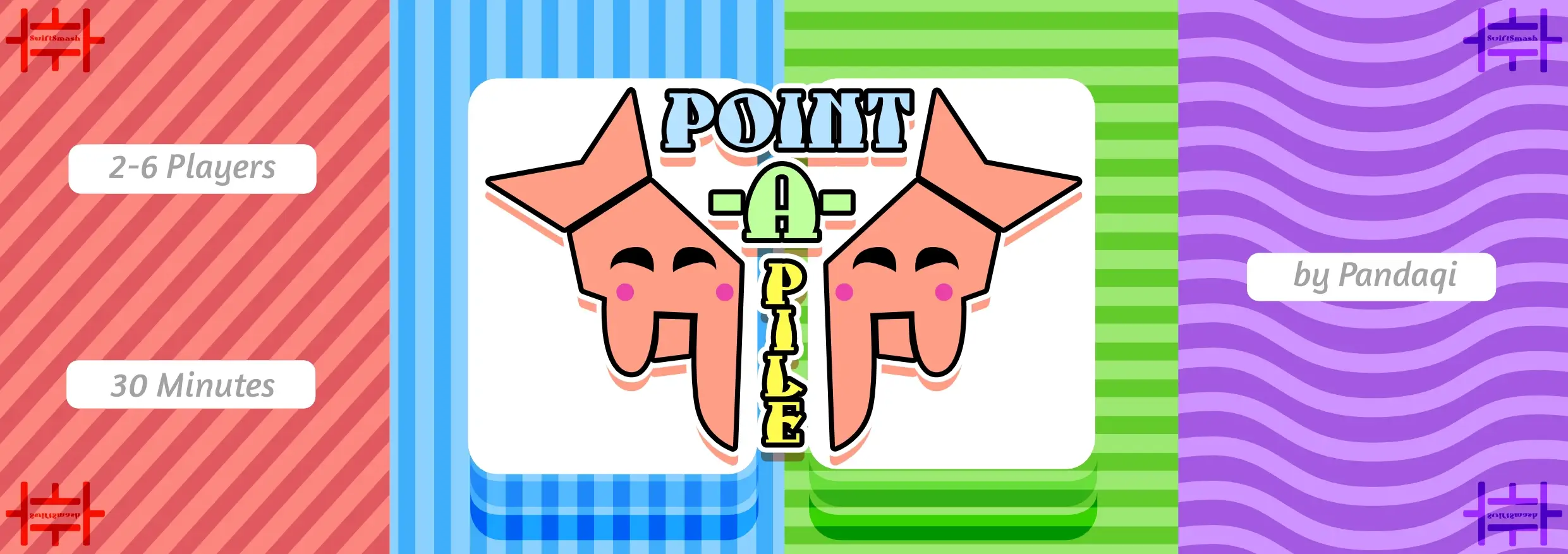Turn all cards into a single deck. Shuffle it and place it facedown on the table. Pick any player to be Headpointer ( = start player).
The game ends as soon as a player has 10 points. They win!
First, the active player creates piles.
- They draw twice as many cards as the number of players from the deck.
- They distribute them into at most as many piles as the number of players.
- Anyone is allowed to look at all the contents of your piles; it’s not supposed to be secret.
Then, everyone picks what they want (simultaneously).
- Everyone raises their finger (to point at the ceiling)
- The active player counts down (3 … 2 … 1 … Point!)
- Everyone taps one of the piles with their fingertip. You may also tap empty space on purpose.

Now resolve who gets what.
- If nobody wanted a certain pile, discard it.
- If only a single player wanted a pile, they score those cards.
- Otherwise, if multiple players point to a pile, split the pile and repeat the process.
- The Headpointer splits the pile into (at least two) smaller piles and counts down.
- Those players—who wanted the original pile—point at what they want now.
- Resolve as stated above.
- If the pile can’t be split any further ( = it’s 1 card), discard the pile.
If only a single player tapped empty space this round, they score all cards that would otherwise be discarded. Otherwise they just get nothing.

Cards scored are simply placed faceup in front of you, in a row that grows longer and longer. The final card in this row is always your “last card scored”; this is especially important for the expansions.
When all piles are handled, the Headpointer moves to the next player in clockwise direction. Next round!
Played the base game and ready for more? Or looking to tweak the game to fit your playing group better? Check out these variants and expansions!
All the expansions are tiny and only add ~10 more cards of a new type. I merely split these cards into many small expansions to make the rulebook cleaner and give you full control over what you print or want to include.
For a harder game (that requires a better memory), keep the scored cards in a single faceup pile.
- Other players can only ever see the top-most card, which is the last card you scored.
- You are allowed to look back into your score pile and count your points at any time.
This expansion adds new material: Rule Cards. They contain a rule stating which piles someone is allowed to point at in the first place.
Each round, before pointing,
- Check the last card scored of the Headpointer.
- If it’s a Rule Card, that rule must now be followed by all players.
- (Otherwise, you can ignore them.)
If you point at an invalid pile, according to this rule, you are out of the round. Remove your finger; you get nothing.

This expansion adds new material: Mission Cards.
During setup, everyone draws a secret Mission. This card tells you exactly when you win.
The game ends when a player reveals they’ve won (according to their personal mission).

This expansion adds new material: Shy Cards. They have a rule about who may (not) tap them.
These rules are only in effect if that card is at the top of its pile ( = it’s visible/readable).
There must always be at least 1 pile without a Shy card on top.

This expansion adds new material: Action Cards.
- If you have an action card inside your score pile, you may trigger it at any time.
- Reveal the card and execute its action.
- When done, discard the card.
You may only execute one special action per round.
These cards usually provide a sneaky way to overrule the game’s default rules and get what you want.

